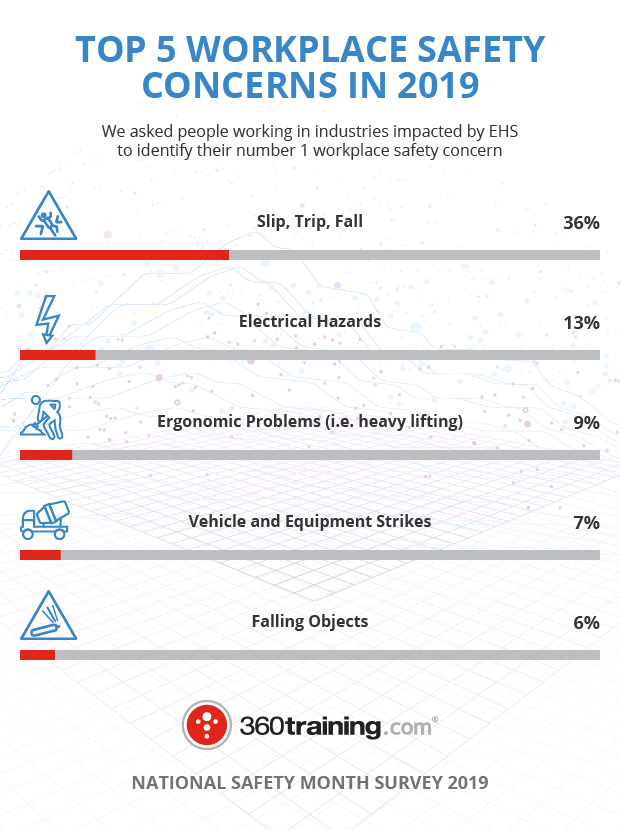by Brianna Crandall — May 29, 2019 — Members of the workforce, especially those in industries that require manual labor, are becoming increasingly concerned about injury and fatality while on the job, points out 360training.com, a provider of workplace safety training around the world.
In honor of National Safety Month coming up in June, 360training.com surveyed 1,069 adults (18+) who work in industries impacted by environmental health and safety (EHS) (construction, oil & gas, manufacturing, etc.) to learn about their top safety concerns and explore their views on EHS issues.
A full 39% of all respondents are more concerned with on-the-job safety this year than they were last year, underscoring the need for effective, ongoing safety training and preparation.
According to the 2018 Bureau of Labor Statistics’ (BLS) National Census of Fatal Occupational Injuries (CFOI), workplace fatalities were up 11% in 2017 compared to just five years prior (4,628 in 2012 vs. 5,147 in 2017). Though some causes of fatality are declining, such as injuries by persons or animals, other causes are proving more dangerous, such as fatal falls.
For many, on-the-job safety concerns are always present: 25% of all respondents worry about getting injured because of their job on a daily basis.
The survey shows how the top safety concerns differ by industry, job role, generation and gender, and lists the top workplace safety concerns in 2019 along with solutions to reduce them. Highlights appear below.
Top workplace safety concerns
Across the board, respondents indicated “slip, trip, or fall” as their top workplace safety concern. This was followed by:
- Slip, trip, or fall (36%)
- Electrical hazards (13%)
- Ergonomic problems (i.e. heavy lifting) (9%)
- Vehicle and equipment strikes (7%)
- Falling objects (6%)
Industry
Workers in construction and oil & gas more likely to fear for their lives on a daily basis. Construction workers are 27% more likely than those in other industries to worry every day about getting injured because of their job. This is understandable given that the CFOI showed one in five of all workplace fatalities occurred in the construction industry in 2017.
While overall workers identified “slip, trip, or fall” as their top concern, their next biggest safety concern varied based on their industry:
- Construction: Electrical hazards (13%)
- Manufacturing: Ergonomic problems (16%)
- Oil and Gas: Gas or chemical exposure (18%)
- Transportation: Vehicle and equipment strikes (23%)
- Utilities: Electrical hazards (27%)
Job role
Frontline employees — those who identified as workers and handlers — report the most workplace safety concerns; they are 117% more likely to worry about losing their life because of their job and are 70% more likely to worry about getting injured because of their job on a daily basis, when compared to those in other positions.
Generation
Baby Boomers (ages 55 – 73) are 27% more likely than Gen Xers (ages 39 – 54) to say they are more concerned with on-the-job safety this year than they were last year, and 34% more likely than Millennials (ages 23 – 38).
Baby Boomers, who are largely rejecting the traditional retirement age of 65, showed the biggest spike in concern for on-the-job safety this year versus last year — and suffered the highest number of fatal work injuries in 2016. Even so, Millennials are 78% more likely to worry about losing their life because of their job on a daily basis when compared to Baby Boomers, possibly due to training courses that have made them more aware of potential workplace safety hazards.
Gender
While both men and women identified “slips, trips, and falls” as their top workplace safety concern, there are some major differences when comparing other workplace safety concerns between women and men:
- Women are 500% more likely to identify workplace violence as their number one safety concern, and 100% more likely to identify ergonomic problems as their number one safety concern, when compared to men.
- Men are 200% more likely to identify falling objects as their number one safety concern, and 100% more likely to identify electrical hazards as their number one concern.
Existing and desired training
Employers are investing in job-skills and career-development training, but there’s still room for improvement. The survey discovered that while 65% of respondents agreed their employer invests in job-skills and career-development training, 56% of respondents also expressed they are extremely interested in receiving more.
Respondents in the construction industry were 18% more likely to say their employer invests in job-skills and career-development training, while workers in manufacturing and utilities were 56% and 53% more likely, respectively, to respond that their employers did not invest in such training.
These survey results highlight the need for additional, industry-specific training, concludes 360training.com. Taking advantage of training resources, like the ones 360training.com provides, can improve worker and handler understanding of safety expectations, even for those with years of experience. The ideal solution is to pair online courses with in-person training sessions so employees learn about general safety issues as well as hazards related directly to their specific jobs, says the company.
Visit the 360training.com “New Survey Reveals Rise in Workplace Safety Concerns” blog entry for more details about the survey as well as links to the company’s top OSHA and safety courses and suggestions for other career-advancement certification programs.






